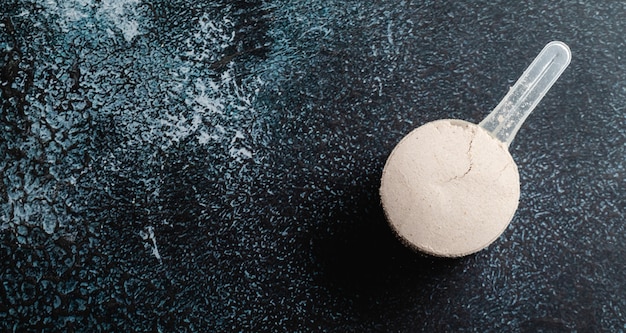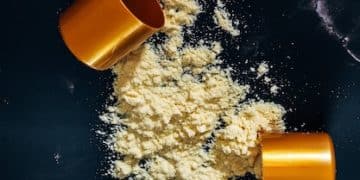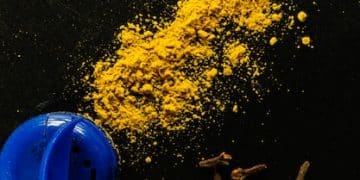Creatine Monohydrate vs. HCL: Faster Results in the US Market?

When choosing between creatine monohydrate and creatine HCL, the primary factor for faster results in the US market often hinges on individual absorption, though monohydrate’s extensive research supports its proven efficacy for performance gains.
For individuals seeking to optimize their athletic performance, the debate over which creatine form delivers the fastest results in the US market is a frequent and crucial topic. Among the various creatine formulations available, Creatine Monohydrate vs. HCL: Which Form Delivers Faster Results in the US Market? stands out as a fundamental question. This article delves into the nuances of each type, examining their mechanisms, typical absorption rates, and overall efficacy to help you make an informed decision tailored to your fitness goals.
Understanding Creatine Monohydrate: The Gold Standard
Creatine monohydrate is arguably the most researched and widely used form of creatine. Its long history in sports nutrition, coupled with an extensive body of scientific literature, firmly establishes its reputation as “the gold standard.” This form consists of a creatine molecule bound to a water molecule, which aids in its delivery and storage within muscle cells.
The efficacy of creatine monohydrate is well-documented. Numerous studies have consistently shown its ability to enhance strength, power, and muscle mass, particularly in high-intensity, short-duration activities. Its mechanism involves increasing phosphocreatine stores in muscles, which then facilitates the rapid regeneration of adenosine triphosphate (ATP), the primary energy currency of cells. This means more energy for explosive movements and quicker recovery between sets.
Mechanism of Action and Absorption
Upon ingestion, creatine monohydrate is absorbed into the bloodstream. From there, it is transported to muscle cells, where it is converted into phosphocreatine. This process is crucial for the energy systems that power bursts of activity. The absorption rate can vary slightly among individuals due to factors like gut health, diet, and hydration status. However, generally, creatine monohydrate is well-absorbed by most users.
- Increased Phosphocreatine Stores: Directly fuels rapid ATP regeneration for high-intensity exercise.
- Enhanced Muscle Strength: Supports greater resistance to fatigue during lifting and sprinting.
- Improved Power Output: Allows for more explosive movements and repetitions.
- Muscle Growth: Facilitates an anabolic environment conducive to lean muscle gain.
While often associated with a “loading phase,” scientific evidence suggests that a consistent daily dose, typically 3-5 grams, can achieve similar saturation levels over a slightly longer period. This approach may also minimize potential gastrointestinal discomfort sometimes reported during loading.
The time to see results with creatine monohydrate can vary. Some users report noticeable effects within a week, especially with a loading phase, while others might take 3-4 weeks to experience full benefits with a consistent maintenance dose. These benefits include increased strength during compound lifts and improved endurance during multiple sets.
The safety profile of creatine monohydrate is also robust, with decades of research indicating it is safe for healthy individuals when used appropriately. Side effects are generally mild and uncommon, often related to gastrointestinal upset or temporary water weight gain, particularly during a loading phase. This has contributed significantly to its enduring popularity and widespread use in the fitness community.
Deconstructing Creatine HCL: A Modern Alternative
Creatine HCL, or creatine hydrochloride, represents a newer formulation in the creatine market. It is essentially a creatine molecule bound with a hydrochloride group. The primary claim for creatine HCL is its superior solubility and absorption compared to monohydrate, theoretically leading to faster saturation of muscle cells and fewer side effects like bloating or gastrointestinal distress.
The idea behind HCL’s enhanced solubility is that the hydrochloride group makes the creatine molecule more stable in the acidic environment of the stomach. This purportedly prevents its breakdown into creatinine, an inactive byproduct, and allows more of the active compound to reach the muscles. For consumers, this could mean smaller effective doses and potentially quicker performance benefits without the water retention sometimes associated with monohydrate.
Absorption Claims and Real-World Evidence
Manufacturers often highlight HCL’s “micro-dosing” capability, suggesting that effective results can be achieved with significantly smaller amounts than monohydrate. While solubility studies do support HCL’s increased dissolution in water, the direct translation of this to superior absorption in the human body, leading to faster results, isn’t as extensively researched as monohydrate.
Creatine HCL’s appeal often lies in its purported lack of a “loading phase,” as its enhanced solubility theoretically allows for efficient muscle saturation with consistent daily, lower doses. This convenience, combined with claims of reduced bloating, makes it an attractive option for those sensitive to monohydrate.
However, the scientific community is still accumulating data on creatine HCL to match the extensive research base supporting monohydrate. While anecdotal reports and some preliminary studies suggest benefits, a definitive consensus on its superior efficacy or speed of action over monohydrate is not yet established. The real-world difference in “faster results” might be subtle and highly individual, depending on how each person’s body processes the different forms.
The cost of creatine HCL is generally higher per gram than creatine monohydrate. This price difference is often justified by the claims of lower effective doses and superior absorption. For consumers, weighing the perceived benefits against the higher cost is an important consideration, especially when performance gains are the primary objective.
Comparing Speeds: Which Creatine Form Delivers Faster Results?
The central question in the Creatine Monohydrate vs. HCL: Which Form Delivers Faster Results in the US Market? debate revolves around the speed of efficacy. While both forms ultimately aim to increase phosphocreatine stores in muscles, the pathway and perceived time to initial benefits can differ.
Creatine monohydrate, particularly with a loading phase (20g/day for 5-7 days, then 3-5g/day), can lead to muscle creatine saturation relatively quickly—often within a week. Users typically report noticeable increases in strength and power shortly after saturation is achieved. The “results” observed during this period are primarily due to increased energy availability for high-intensity exercise.

Creatine HCL, due to its claimed superior solubility, is often marketed with the promise of faster absorption and quicker results without the need for a loading phase. The theory is that smaller doses are needed, and these doses are absorbed more efficiently, leading to rapid saturation. Anecdotal evidence from users sometimes supports this, with some reporting less bloating and faster perceived effects compared to monohydrate. However, direct head-to-head scientific studies unequivocally proving HCL’s superiority in terms of “faster results” in a human performance context are still limited compared to the vast body of research on monohydrate.
- Monohydrate: Proven saturation via loading phase in ~7 days. Consistent daily dosing achieves saturation in ~3-4 weeks.
- HCL: Marketed for faster absorption without loading, potentially quicker perceived effects due to reduced GI discomfort.
- Clinical Evidence: More extensive body of research supports and quantifies monohydrate’s effects. HCL research is growing but is less conclusive on “faster” performance gains.
It’s crucial to distinguish between perceived faster results and clinically significant faster results. For some individuals, avoiding the subtle gastrointestinal discomfort or water retention associated with monohydrate’s loading phase might make HCL feel “faster” or more effective simply because the initial experience is more benign. However, this doesn’t necessarily mean the actual physiological benefits manifest more rapidly.
Ultimately, consistency is key for both forms. While one might theoretically be absorbed slightly faster, the long-term benefits of creatine taxation on performance and muscle growth are achieved through consistent daily intake over weeks and months, not just days. Individual biological variability also plays a significant role; what feels “faster” for one person might not for another.
Factors Influencing Creatine Absorption and Results
Several factors can influence how quickly an individual experiences the benefits of creatine, regardless of whether they choose monohydrate or HCL. Understanding these elements can help manage expectations and optimize the creatine supplementation experience.
Individual Physiology
Every person’s body is unique. Variations in gut microbiome composition, digestive enzyme activity, and metabolic rate can all impact how efficiently creatine is absorbed from the digestive tract into the bloodstream and then into muscle cells. People with certain gastrointestinal sensitivities, for example, might find one form of creatine more tolerable than another, which indirectly impacts their ability to consistently take it and thus experience results.
Furthermore, an individual’s baseline creatine stores play a role. Those with naturally lower muscle creatine levels (e.g., vegetarians or vegans) may experience more pronounced and potentially “faster” initial effects compared to individuals who already have higher baseline levels.
Dosage and Consistency
While often overlooked, adhering to the recommended dosage and maintaining consistency are paramount. Skipping doses or taking insufficient amounts will undoubtedly delay desired results. For monohydrate, a typical maintenance dose is 3-5g per day. For HCL, due to its higher solubility claims, doses are often lower, perhaps 0.75-1.5g per day, though these recommendations can vary by manufacturer and specific product.
Consistency means taking creatine daily, even on rest days. Muscle creatine saturation is a cumulative process, not an acute one. Regular intake ensures maximal loading and maintenance of phosphocreatine stores, thereby supporting continuous improvements in performance.
Diet and Hydration
The context within which creatine is taken matters. Consuming creatine with carbohydrates and/or protein can enhance its absorption due to the insulin response, which helps shuttle creatine into muscle cells. This is why many recommend taking creatine post-workout alongside a meal or shake.
Hydration is equally critical. Creatine draws water into muscle cells, which is part of its mechanism for increasing cell volume and stimulating protein synthesis. Insufficient water intake can hinder this process and may even lead to digestive discomfort. Aim for increased daily water intake when supplementing with creatine to support its efficacy and minimize potential side effects.
These factors collectively shape the real-world effectiveness and the perceived speed of results from creatine supplementation. An optimized approach considers not just the form of creatine but also how it integrates with an individual’s diet, hydration, and overall training regimen.
Side Effects and Safety Profiles: Monohydrate vs. HCL
When considering any supplement, understanding its safety profile and potential side effects is paramount. Both creatine monohydrate and creatine HCL are generally considered safe for healthy individuals, but there are differences in user experience and reported adverse effects that are worth examining.
Creatine Monohydrate Side Effects
The most commonly reported side effect of creatine monohydrate, especially during a loading phase (20g per day), is gastrointestinal distress. This can manifest as bloating, stomach cramps, or diarrhea. This is often attributed to creatine drawing water into the intestines. To mitigate this, some users opt to spread their daily dose throughout the day or forego the loading phase entirely, allowing for a slower, more gradual saturation of muscle creatine.
Temporary water retention leading to slight weight gain is another well-known effect of creatine monohydrate. This is not fat gain but rather water being drawn into muscle cells, which is part of its beneficial action. For some, this effect is unnoticeable, while others may experience a slight puffiness. Over the long term, creatine monohydrate has been extensively studied and found to be safe for kidney and liver function in healthy individuals when taken at recommended dosages.
Creatine HCL Side Effects
Creatine HCL’s main selling point is its purported reduction in side effects, particularly bloating and gastrointestinal distress. Because it claims to be more soluble and effectively absorbed at lower doses, the notion is that less unabsorbed creatine remains in the gut to draw water, thus minimizing discomfort. Anecdotal evidence suggests many users find HCL to be gentler on their stomach.
However, while less common, some individuals may still experience mild digestive upset with HCL. The long-term safety data for creatine HCL, while promising, is not as extensive or robust as that for creatine monohydrate due to its more recent introduction to the market. Despite this, there is no current evidence to suggest that creatine HCL is inherently unsafe.
Neither form of creatine is associated with hair loss, kidney damage in healthy individuals, or other serious adverse effects. The key is to source from reputable manufacturers, adhere to recommended dosages, and increase water intake, especially when first starting supplementation. Consulting with a healthcare professional before starting any new supplement regimen, especially for those with pre-existing health conditions, is always recommended.
Optimizing Your Creatine Choice for US Market Results
Navigating the US supplement market for creatine can be overwhelming given the array of choices. When deciding between creatine monohydrate vs. HCL: Which Form Delivers Faster Results in the US Market?, an informed approach considers individual needs, scientific backing, and practical considerations.
Consider Your Body’s Response
The most significant factor often comes down to individual tolerance and how your body responds to each form. If you’ve previously experienced gastrointestinal discomfort or bloating with creatine monohydrate (especially during a loading phase), creatine HCL might be a suitable alternative to try. Some individuals simply prefer the smaller dosage requirement of HCL and the perceived convenience.
However, if you’ve had positive experiences with monohydrate without noticeable side effects, there may be little compelling reason to switch. The “fastest” results are those you can maintain consistently without discomfort.
Evaluate the Science and Cost-Effectiveness
Creatine monohydrate boasts an unparalleled volume of scientific research supporting its efficacy, safety, and ability to deliver performance benefits. It’s also significantly more cost-effective per serving, making it a budget-friendly option for long-term supplementation. For those prioritizing proven results and cost, monohydrate typically remains the optimal choice.
While HCL research is expanding, it has not yet reached the same depth as monohydrate. While some studies suggest benefits and improved solubility, clinical trials directly comparing HCL’s superior and faster performance benefits against monohydrate on a large scale are still emerging. The higher price point of HCL should be weighed against these considerations.
Focus on Consistency and Overall Training
Regardless of the creatine form chosen, consistency in daily intake is paramount for saturating muscle creatine stores and achieving results. Adhering to either a loading phase followed by maintenance (for monohydrate) or a consistent daily lower dose (for HCL) will be more influential than the marginal differences in absorption speed between the two forms.
Furthermore, creatine is a supplement, not a magic bullet. Its effectiveness is maximized when combined with a well-structured training program, adequate nutrition, and sufficient rest. These foundational elements will always contribute more to “faster” and more significant results than a slight edge in creatine absorption speed alone.
In essence, the choice between monohydrate and HCL for faster results often boils down to personal preference for minimizing side effects, budget considerations, and a desire to experiment with newer formulations. For most, creatine monohydrate remains the most reliable and scientifically backed choice for effective and sustained performance enhancement.
| Key Point | Brief Description |
|---|---|
| 💪 Creatine Monohydrate | The most researched form with proven efficacy for strength and muscle growth. |
| 🧪 Creatine HCL | Newer form, claimed higher solubility, potentially less bloating, but less research. |
| ⚡ Speed of Results | Monohydrate with loading phase can saturate muscles in ~7 days. HCL benefits often perceived quicker due to reduced GI issues, but not always faster performance gain. |
| 💰 Cost-Effectiveness | Monohydrate is significantly more cost-effective per serving due to lower production costs. |
Frequently Asked Questions
For beginners, creatine monohydrate is often recommended due to its extensive research, proven efficacy, and cost-effectiveness. While HCL might appeal with claims of no bloating, monohydrate delivers reliable results for strength and muscle gain, making it a solid starting point for those new to creatine supplementation without needing a “faster” path.
Many users report less bloating with creatine HCL compared to monohydrate, especially during the loading phase of monohydrate. This is attributed to HCL’s higher solubility, which lessens the amount of undissolved creatine that can draw water into the intestines. However, individual responses vary greatly depending on dose and hydration.
With a monohydrate loading phase, you might notice strength improvements within a week. Without loading, it can take 3-4 weeks for full muscle saturation. HCL users often report feeling effects sooner due to less perceived discomfort, but the actual physiological performance benefits typically align with similar saturation timelines as monohydrate taken consistently.
While technically possible, there’s generally no added benefit to taking both creatine monohydrate and HCL simultaneously. Your muscles can only store a finite amount of creatine. Combining them won’t lead to faster saturation or enhanced benefits beyond what a single effective dose of either form can provide. Stick to one form for simplicity and efficacy.
Creatine primarily benefits short, explosive efforts, which are less central to pure endurance sports. While both forms can slightly aid recovery and maintain muscle mass during intense training, there’s no strong evidence that one is significantly better for endurance athletes over the other. Most endurance benefits come from diet and training adaptations.
Final Thoughts on Choosing Your Creatine
The quest for faster results in the world of fitness supplements is constant, and creatine remains at the forefront of this discussion. When weighing the options between creatine monohydrate and creatine HCL for the US market, it becomes clear that while both aim to enhance performance, their pathways and user experiences can vary. Creatine monohydrate, with its extensive research and proven track record, continues to be the most reliable and cost-effective choice for consistent strength and muscle gains. It offers a clear, scientifically supported path to muscle saturation, often within a week with a loading phase. Creatine HCL presents itself as a modern alternative, appealing primarily to those who experience gastrointestinal discomfort with monohydrate or prefer a smaller dose. While its increased solubility is a valid chemical property, the evidence for its definitively “faster” or superior performance benefits in real-world scenarios is still emerging and not as robust as monohydrate’s.
Ultimately, the “faster results” debate often boils down to individual tolerance, perceived comfort, and personal preference rather than a significant difference in physiological outcome or speed of muscle saturation between the two forms. For most individuals, consistency in supplementation, coupled with a well-designed training program and adequate nutrition, will yield the desired performance enhancements, regardless of whether they choose the tried-and-true monohydrate or the newer HCL. Always prioritize scientific backing, individual response, and overall health when making your choice.






